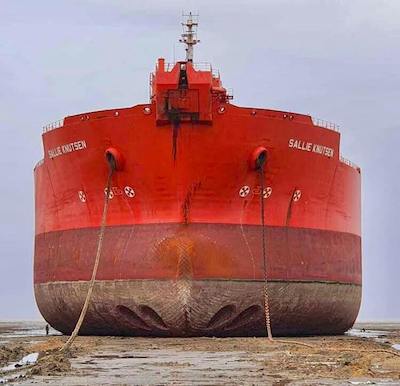“Shipbreaking” # 64
Bulletin of information and analysis on ship demolition
July-August-September 2021
85 pages, 102 sources, 302 photos (+ 3 maps), 16.1 Mo
https://robindesbois.org/wp-content/uploads/shipbreaking64.pdf
 Sallie Knutsen, Alang © Eren Topcu
Sallie Knutsen, Alang © Eren Topcu
Business has picked up again. Average purchase price from yards in the Indian sub-continent has reached 600 US$ per ton compared with 350 US$ at the same time in 2020.
149 vessels out of 178 were scrapped in the Indian sub-continent, 12 in Turkey and 7 in European Union yards, 6 of which were assigned to the North Sea offshore oil industry.
55 of the vessels to be scrapped were built in the European Union, Norway and the United Kingdom.
At the end of their lives, the VLCCs Hapon and Peron each brought in 28 million US$ to their owner. Their sistership EM Vitality was sold in May 2021 for 24 million US$. In this year 2021 marked by the “whatever it takes” recovery in the international trade, the more shipowners, brokers and cash buyers postpone scrapping, the more money they make. Several ships including 4 tankers, one bulker and one cruise ship that were reported sold during the 2nd quarter and 3rd quarter of the year 2021 and were considered by the official databases as “to be broken up” did not reached the shipbreaking yards. They are waiting in ports worldwide. The Phoenix I, a 269 meter-long bulker with a lightweight of 17,724 tons, the sale of which had been negotiated at 552 US$ per ton, is now again “in service”. She should be sold this winter at least for 600 US$, i.e. a gain of 850,000 US$.
Oil and gas are in a fog. 54% of ships to be broken up from July to September 2021 had a link with the offshore oil industry and the transport of hydrocarbons. One drilling ship, the NS Cassino was sent for scrapping before even having been operated.
Container ships are deserting the shipbreaking yards. After the losses of years 2012-2013 and 2016-2017, shippers are fighting up for those still on the market. Between July 1 and September 30, 2021, out of the 178 vessels scrapped, only 2 were container ships.
60 vessels were flying a funeral flag for their last voyage. The most used are Saint Kitts and Nevis, Comoros, Gabon, Mongolia, Palau and Sierra Leone.
“Shipbreaking” is a reflection of the world with its schemes and human rights violations.
The ex-cruise ship Albatros belonged to the German ship owner Bernhard Schulte Cruise Services GmbH & Co KG. Through some sleight of hand, it got rid of its burden without having to comply with European regulations. The Albatros, which became the Tros, is currently being scrapped in an Alang yard.
The oldest ship of the quarter is also the most scandalous. The ex-Risa Paula built in 1962 in the Netherlands became over the centuries the Blissful Reefer, flying the Cameroon flag for her last voyage to Bangladesh. In 2015, the Honduras-flagged Blissful Reefer had been arrested by Papua New Guinea. According to the International Organization for Migration, her Thai shipowner, specialized in fishing and fish transport, was part of a wide human trafficking network. Victims were recruited in Cambodia, Burma and Laos and employed as forced labourers on board its substandard ships.
In the military field, Germany and Italy feed the Turkish yards of Aliaga with ex-surface navy vessels and even with the Bagnolini, an old submarine which was discarded in Augusta Bay, Sicily.
The aircraft carrier NAel Sao Paulo ex-Foch, sistership of Clemenceau, is still waiting to be towed to Aliaga.
The French Navy continues its efforts to dismantle its ex-vessels in France by EU-approved yards. In Le Havre, the yard Gardet & De Bezenac has inherited the so-called Minirem, an unidentified floating object. This ex-nuclear service tender was long used as a repositery for the cooling water of nuclear-powered submarines during maintenance at Ile-Longue in the Bay of Brest. Then, she used to spill them off Ushant. After years of services in Britanny, she was transferred to the naval (and nuclear) base of Toulon. Robin des Bois recommends uttermost caution during the Minirem‘s dismantling and segregation of part of her scrap metal away from recycling. Her story can be read on p. 11.
 Imprimer cet article
Imprimer cet article









